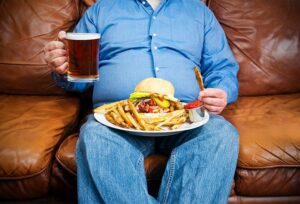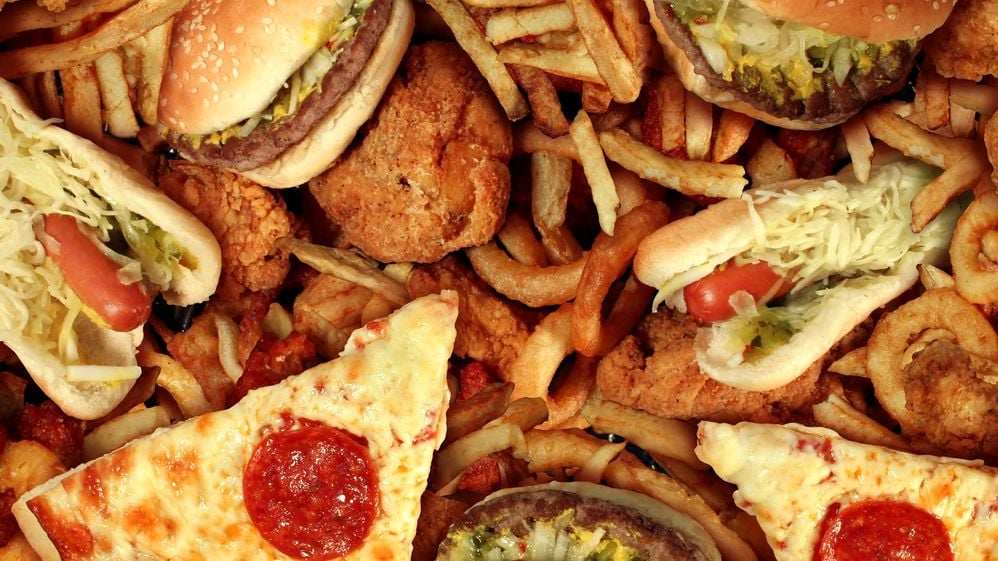If you have ever tried to diet, it can seem like a herculean task. It’s hard enough to resist the temptation of fatty food at home, let alone when eating out with your friends or family. This article suggests ways that you can stop fatty food temptations such as switching to herbal tea, choosing smaller portions, and creating healthy alternatives for recipes.
Contents
What Are Fatty Food Temptations?

There are many different food temptations that can be difficult to resist. These temptations can come in the form of foods that we know are bad for our health, like junk food, but also foods that we think are good for us, like healthy foods.
Sometimes it can be hard to resist these temptations because they make us feel good. However, what is good for our minds and emotions may not be good for our bodies. We need to be careful about what we eat and how much we eat.
Snacks high in fat
When you often have fatty food temptations, it’s good to know what foods are high in fat. Snacks high in fat can be dangerous for your health, so it’s important to make healthy choices when picking them. Here are some of the most common fatty snacks:
- Chips and dips: These snacks are high in fat and calories, and they’re often served with unhealthy toppings like salsa or guacamole. Choose low-fat versions instead or choose a dip that’s made without cream cheese or sour cream.
- Cookies and cake: Both cookies and cake are often high in sugar and fat, which can cause weight gain over time. Try replacing some of the sugar with healthier alternatives like raisins or nuts.
- Fried Foods: Fried foods are usually high in fat and calories, and they’re not good for your health either nutritionally or psychologically. They’re also often accompanied by unhealthy sauces and condiments. Try substituting fried foods with grilled or baked equivalents instead.
Why Am I Craving Fatty Foods?
People often have fatty food temptations because they are missing out on essential nutrients. When you deprive yourself of certain nutrients, your body starts to search for them in other ways. This can lead to cravings for fatty foods. You might also be craving fatty foods because you’re feeling stressed or anxious.
When your body is stressed, it releases hormones that can make you crave unhealthy food. Some people may be experiencing symptoms of sugar or carb withdrawal, while others may be trying to lose weight. Regardless of the reason, if you’re struggling to break your food addiction to fatty foods, here are a few tips that may help:
Triggers
There are a number of triggers that can lead to fatty food temptations. Some people feel more inclined to eat fatty foods when they’re stressed, anxious, or feeling frustrated. Other people may indulge in fatty foods when they’re bored or when they’re feeling emotional highs and lows (like after a happy meal). Whatever may be the reason, it’s important to know your trigger point and work on it. So, here are the most important triggers:
Sight
Seeing some foods can trigger a response in your brain causing you to crave those foods. Hide fatty foods in places you typically wouldn’t think of looking. For example, if you usually have cereal for breakfast, put it in the pantry instead. Or, if your favorite dish is cheesy fries, put them in the freezer instead of the cabinet. This way, you won’t see them as often and they’ll be less likely to tempt you.
Smell
There are a lot of smells that can be triggers for people with eating disorders. For some, the smell of food can make them feel sick or anxious. It’s important to know which smells trigger these reactions in order to avoid them during meals. Some common smells that can be triggers for people with eating disorders include: Bread baking, Chips, and crisps, Cheeses, Fast food
Emotional eating

There are many things that can trigger emotional eating, but some of the most common are feeling deprived or lonely. Other triggers can include stress, boredom, or feeling overwhelmed. However, the most potent emotional eating trigger is often something that we ourselves perceive as a threat to our health or well-being.
This could be anything from seeing someone else eat an unhealthy meal to worrying about our own weight or fitness. If we perceive any of these threats as genuine, we’re likely to reach for food as a way of dealing with them. In fact, studies have shown that people who suffer from binge eating disorder are more likely to interpret negative emotions, like stress or anxiety, as signs that it’s time for a snack.
Sound
Sound triggers can be the deciding factor between eating healthy or unhealthy food. By identifying sound triggers, you can make healthier choices when it comes to what and how much you eat. When making decisions about food, consider the following sound triggers: crunching on nuts, biting into a watermelon, slurping up a smoothie.
Taste
There are a few things that can trigger our taste buds to respond favorably to fatty foods. One of these is the smell of garlic. Garlic is a strong-smelling herb and when it is mixed with some fat, like olive oil, it can create a powerful smell that stimulates the taste receptors in our noses. Other things that can stimulate our taste buds are sweet flavors, sour flavors, and savory flavors.
Risks Of Eating Fatty Foods

Eating fatty foods can be tempting, but it’s important to take into account the risks. Eating a lot of unhealthy fats can increase your risk of several diseases. Some of these include:
Heart Health
If you’re looking to improve your heart health, you may want to avoid fatty foods. Fatty foods can contain unhealthy fats that can increase the risk of heart disease.
In fact, a study published in The American Journal of Clinical Nutrition found that people who ate a high-fat diet were more likely to have a heart attack than those who ate a low-fat diet. Furthermore, a Harvard University study found that people who ate a lot of saturated fat were more likely to have a heart attack than those who ate less saturated fat.
Hypertension
Eating fatty foods can increase blood pressure and cause hypertension. High blood pressure is a major risk factor for heart disease and stroke. People with high blood pressure are more likely to have a heart attack or stroke than people with normal blood pressure.
The main types of fat are unsaturated (healthy) fats and saturated (bad) fats. Unsaturated fats include olive oil, nuts, and avocados. Saturated fats include animal fats (such as butter, lard, and cream), coconut oil, and palm oil. Most of the fat in our diets comes from saturated fatty acids. These acids raise blood pressure by raising the levels of “bad” cholesterol in the blood.
Diabetes
Fatty foods are bad for your health and can lead to diabetes. Eating fatty foods can increase your risk of developing type 2 diabetes by raising your blood sugar levels. In addition, eating fatty foods can increase your risk of heart disease, stroke, and other chronic conditions. Eating fatty foods can also increase your waistline.
Eating a lot of unhealthy fats can pack on the pounds, leading to obesity and a host of health problems, including type 2 diabetes. While it’s important to get enough good fats in your diet, you don’t need to eat tons of them to have a negative impact on your health.
Stroke
The consumption of fatty food can increase your risk of stroke by up to 30%. This is because fatty foods contain high levels of cholesterol and other fats that can clog up arteries. When this happens, it can lead to a heart attack or stroke.
How Can You Stop Fatty Food Temptations?
There are some tips you can follow to stop the temptations:
- Make sure you’re getting enough protein and healthy fats every day: Protein helps to stabilize blood sugar levels and keep us feeling full longer, while healthy fats help to promote satiety and reduce cravings. Try incorporating high-quality lean protein sources like salmon, chicken, eggs, or tofu into your meals regularly.
- Avoid eating out at fast food restaurants as often as possible: Many of the menu items at these restaurants are high in unhealthy fats and calories. Instead, try cooking your own meals at home using whole grains, fruits, and vegetables as ingredients.
- Exercise regularly: Exercise has been shown to reduce cravings for unhealthy foods and can also help improve overall mood and energy levels. If you find it difficult to stick to a regular exercise routine, consider working with a personal trainer who can help guide you through specific exercises that will target your specific needs.
- Talk about your food addiction with a trusted friend or family member: Sharing your struggles with someone who understands will make them easier to deal with and could lead to lasting changes in your eating habits
Tips For Eating Out
It’s inevitable not to go outside once in a while, and what you eat outside determines how likely you’re to eat inside. When you’re on a diet, it can be really tough to stick to your food choices. But with a little bit of creativity and know-how, you can make eating out a lot easier. Here are some tips for eating out when you’re on a diet:
- Make sure your meal is small and frequent: Eating big meals all at once is not going to help you lose weight, and it will also rack up the calories in your body quickly. Instead, try to have smaller meals more often throughout the day. This way, you’ll be less tempted to overindulge later on in the day.
- Stick to low-fat options whenever possible: When eating out, it’s important to keep an eye on your calorie intake. One way to do this is to stick to low-fat options whenever possible. This way, you won’t be adding tons of extra fat and calories into your system without even realizing it.
- Order without butter or cream sauces: Butter and cream sauces are high in fat and calories, which will easily add up during your meal if you order them without specifying that they don’t contain any butter or cream sauce (or ask for them without those ingredients).
- Skip the appetizers and desserts altogether if possible: If you’re planning on eating out, try skipping appetizers and desserts altogether – both of which tend to be high in fat and sugar content.
When you eat fatty foods, aim for healthier options instead. Examples of healthy fats include omega-3 fatty acids, monounsaturated fats, and polyunsaturated fats. These types of fats help protect you from heart disease and other chronic conditions.
Conclusion
If you’re struggling to resist the temptation to eat fatty foods, it can be tough. But there are some helpful tips to help you break the habit. First, be aware of what temptations are most common for you. Second, try to keep track of how many calories you’re eating and how many grams of fat are in each food item. Finally, make sure to eat healthy snacks between meals to keep your energy levels up and prevent overeating.
So if you’re struggling to stick to your healthy eating goals, it might be worthwhile trying to identify any external triggers that make you feel emotionally vulnerable. Once you know what these are, you can start to work on addressing them in a way that won’t lead you back to the fridge.
Consider contacting FitMantra for additional information on nutrition and fitness. You can also get in touch with their nutrition experts through our online nutrition counseling, who can guide you through the process and help you achieve your fitness goals. You can also lose weight with the help of our weight loss program. Download our FitnessApp on Android to know more about us.
